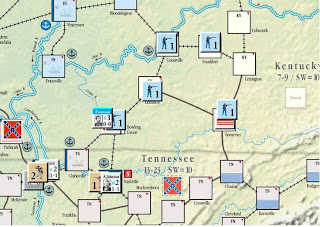Begins turn 2 after resolving political affairs and reinforcement. No special things to point out this time, excepting the fact that in turn 2, seven USA leaders enter the game (they represent corp leaders, so they are generals with a command of some divisions). Most of them are bad leaders, but there are three specially importants. McLlelan, activation of "3" (worst), zero in attack (worst) but a defense of "2" (rating goes from 0 to 3) and a political rating of "10" it means that wherever he goes, he is in charge. And Pope (attack =1, defense=0) and Burnside (attack =0, defense=1) both with an activation rating of "2", it means that they can act with cards of value of "2" and "3". This fact is very important as it usually means that in the first turns of the war USA often can't almost move due to the hand you drew.
On the other hand confederacy receives three leaders, two average ones (Smith and Bragg) and one very important
Stuart, he is the first cavalry leader in the game, so once in an army (biggest military estructure in the game) it is not penalized in combat and can react much better (drm= -2 for retreating and intercepting). It means that once CSA builds army of north Virginia (AoNV), usually at the beginning of turn 2, it has easily a drm for combat of "+4" in attack and "+5" in defense, and his enemy AoP (northern Army of the Potomac) usually has attack "+1", "+1" in defense. So a hard turn for the union to come!
The first activation for Union is to destroy the raiders already in Pennsylvania, Pope gets his 25000 men and destroys both grey divisions in Philadelphia and Harrisburg. In FtP battles are usually very evenly resolved, the combat table doesn't consider a lot the size ratios, being much more important supply status or the rating of the leaders. After the battle (when you begin a battle with at least double troups than the defender, and you win, you can continue with your move) Pope continues to reinforce Dc, Baltimore and AoP at Frederick (Md). Then south creates AoNV, J. Johnston is in charge, it hits in A.J.Johnston ego, with a highest political rating and only a "corp leader" detached in Nashville (Tn), so CSA is penalized with 5 victory points.
Union plays a card to build a fort in Frederick (most direct way to reach WDC) and CSA plays a dvision move (5000 men) from Vicksburg to reinforce Marshal (Tx) to avoid blue advance from Sabine City where 15000 troops are waiting for a future offensive inside Texas.
Next Union card is to rise blockade level, now bkde level=1. It's an abstract way to represent the blockade union navy did to avoid south from receiving war materials.(Each reinforcement phase south has to roll a die
higher than bkde level in order to receive 5000 men in a port for each of the forth blockade zones). Then south plays a reinforcement card which gives 10000 troops in St Marks (Fl).
CAMPAIGN CARD: Union plays another good card (a minor campaign) it lets your side to do two movements in a row (minor) or three (major). First was Freemont deploying a garrison in three espaces in Kentucky, that way if they are supplied at the end of the turn a politcial control marker (PC) is placed. The other movement was Burnside spreading from West Virginia to Manassas detaching 1sp (5000 troops) in each espace. It's risky if your enemy can overun you with a 10 vs1 force, but not the case this time. South plays a political event that passed again to neutral three espaces in Ky. North seeing impossible an offensive from Sabine to inside Texas, uses a naval event to reduce the garrison from 15000 to 10000 (it's the maximun amount that do not takes attrition) and with these 5000 men do an amphibius assault to Morehead City (Nc), each Union controled port is a blockade zone near to be closed. Then south moved AoNV aproaching to WDC, in the way a minor batlle were fought that killed poor old Burnside at Manassas. AoNV moves further after his victory in order to deploy more to reduce attrition.
USA SW=100(-) blkde level=1
CSA SW=95(-) it changed due to the creation of AoNV
turn combat casualties: turn attrition casualties Total (casualties + attrition):
Union: 15,000 15,000 45000
Confederation: 15,000 - 25000
Situation in the east before AONV attacks Manassas (summer 1861)
Kentucky at the end of turn 2, it doesn't join the union due to the political event played by CSA




